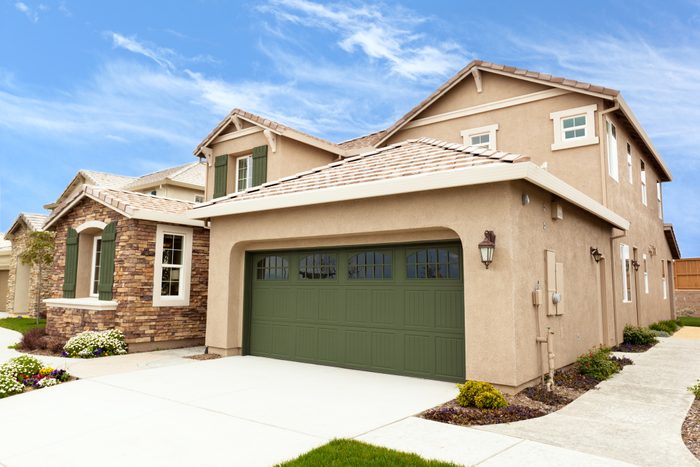Everything You Need To Know About Stucco
Updated: Apr. 24, 2024

Is stucco a good siding choice for your home? Let's find out!
One of the most popular siding options for the outside of a home is also one of the oldest. Stucco has been used for centuries and it remains a popular choice for residential siding.
Nearly 25 percent of single-family homes built today feature stucco siding, according to a 2019 report from the Stucco Manufacturers Association. It ranks as the second-most popular siding in the U.S. behind vinyl. Here’s why it’s a top choice for so many homeowners.
On This Page
What Is Stucco?
Stucco is a cement-like product applied to the exterior of a home in multiple layers about one inch thick. Its texture varies from smooth to textured, depending on how it’s applied. It can be used over masonry or wood frame. Traditionally, it’s made of cement, lime and sand.
There are several newer stucco systems, including acrylic, insulated and crack suppression, that address cracking and other issues that can occur with stucco. (See Why Use Stucco, below.) These offer even more options for texture.
While stucco is popular in Southern and Western U.S., it’s also seen in the Midwest. Now it’s expanding to other regions as newer products solve some of stucco’s limitations.
What are the pros and cons of stucco?
Like all siding materials, stucco has pros and cons you should consider for your specific situation.
Pros of Stucco
- Durability: Unlike other siding materials, stucco has some serious staying power. “When properly applied, it can last for decades without needing maintenance,” says Gregg Cantor, president and CEO of Murray Lampert Design, Build, Remodel. According to a Department of Energy study, “Properly applied stucco will have a useful service life of 100 years.”
- Appearance: Stucco offers unlimited customization. The finish can be anything from super smooth to highly textured. It works well with many architectural styles and other building materials, and can be tinted a range of colors.
- Fire resistance: Stucco provides a strong firewall rating — one hour — which makes it appealing when you need to meet local fire codes.
- Cost: Because applying stucco requires a high level of skill, the cost will vary regionally with labor costs. “In the West, conventional stucco costs about $20,000 for a 3,000 sq. ft. home,” says Cantor. “The newer acrylic systems cost about $25,000 to $30,000.” Cantor says acrylic stucco is “probably going to be more cost effective than traditional wood, vinyl and composite siding.” That’s due to its high durability, low maintenance needs and long lifespan.
Cons of Stucco
- Cracks: If applied correctly, stucco should perform well. Hairline cracks are normal with conventional stucco, and stress cracks can occur as homes settle. But the newer acrylic stucco products and crack suppression systems have greatly decreased cracking.
- Insulation: Conventional stucco doesn’t provide much insulation value. But with new stucco insulation systems, you’ll get better performance.
- Staining: If water runs down stucco, it will stain over time, and you could have larger issues with moisture damage. Use gutters and keep sprinklers away from stucco exteriors.
How to Apply Stucco
Stucco is applied over a base of house wrap or felt paper and lath. It’s typically done in three coats applied by hand with a trowel. Color and texture are added with the final coat.
Application of newer systems vary, based on the specific manufacturer’s product. A crack suppression system requires four coats, and insulating systems require several steps. “They include a polystyrene foam board, followed by fiberglass mesh and an acrylic finish coat,” says Russ Grassa of S.G. Plastering in El Cajon, California.
Can I DIY Stucco or Should I Hire Someone?
“I don’t recommend DIY,” says Cantor. “Very few homeowners would have the skill set required to apply stucco. There are other challenges, too, like the equipment and specialty tools needed.” Cantor adds applying stucco isn’t a one-person job; it takes three or four people.
Taking Care of Stucco
Cantor recommends the following:
- Inspect stucco annually for cracks or damage and repair them as soon as possible so water doesn’t seep behind the stucco finish.
- Stucco typically doesn’t need cleaning. If it’s particularly dirty, hose it off using mild pressure.
- Use gutters and check them periodically to make sure they’re not clogged, damaged or leaking water onto the stucco. Repair gutters as soon as you spot issues to avoid damage or staining.
- Over time, the color may fade. You can paint stucco to refresh it.
- Trim trees and shrubs so they don’t rub against the stucco.
- Don’t put planters that hold water, such as window boxes, against stucco.
- Keep soil levels around the perimeter of the home below the stucco finish. Stucco is porous and can draw up moisture from any soil touching it.
- Use drip irrigation systems around the perimeter of the home. Avoid sprinkling or spraying water onto the siding.
